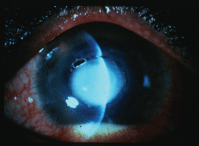Sometimes Mother Nature has already created the best defense. Suzanne M. Fleiszig, O.D., Ph.D., and a team of scientists at University of California, Berkeley, found that small fragments of keratin protein in the eye play a key role in warding off pathogens.

Researchers created synthetic keratin fragments that effectively killed various types of bacteria, including P. aeruginosa, which can cause devastating ulcers like the one seen in this patient. Photo: Joel Silbert, O.D.
The discovery could lead to the development of new, inexpensive antimicrobial drugs with implications well beyond the eye.
“What’s really exciting is that the keratins in our study are already in the body, so we know that they are not toxic, and that they are biocompatible,” says Dr. Fleiszig, who specializes in infectious diseases and microbiology.
Dr. Fleiszig and colleagues created synthetic versions of these keratin fragments and put them to the test against an array of nasty bacteria—they wiped out Streptococcus pyogenes, E. coli, Staphylococcus aureus and Pseudomonas aeruginosa.
The proteins were derived from cytokeratin 6A, which can be found in the corneal epithelial cells and also in the skin, hair and nails. They’re also relatively easy to manufacture, making them good candidates for low-cost drugs.
“We are hoping that our findings will lead to new safe and inexpensive options for treating and possibly even preventing infection,” Dr. Fleiszig says. “While technically it would be feasible to utilize what we have found fairly quickly, we need to proceed with caution because of the potential for microbes to become resistant.”
Lead study author Connie Tam, Ph.D., plans to conduct research on how the body produces and regulates these peptides and which mechanisms they use to kill bacteria. “With more knowledge about these peptides, I believe we can minimize the chance of microbes becoming resistant to future therapeutics,” she says.
Tam C, Mun JJ, Evans DJ, Fleiszig SM. Cytokeratins mediate epithelial innate defense through their antimicrobial properties. J Clin Invest. 2012 Oct 1;122(10):3665-77.

